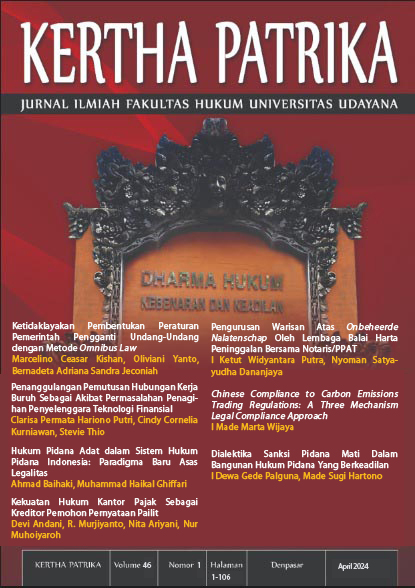Ketidaklayakan Pembentukan Peraturan Pemerintah Pengganti Undang-Undang dengan Metode Omnibus Law
Abstract
This article discusses the government’s acrobatics in forming the Government Regulation in Lieu of Law (as known as Perppu) using the omnibus law method which has caused controversy. The studied aspect is the feasibility of Perppu to be able to use the omnibus law method. Looking further, Law Number 13 of 2022 on the Second Amendment to Law Number 12 of 2011 on The Establishment of Laws and Regulations has restrained the use of omnibus law method in forming laws with the necessity to enact through planning documents. Based on the Legal Restraint perspective, this article is in a negative position to legitimize the use of the omnibus law method in Perppu. The rationalization is because Perppu was formed without using planning documents and it cannot take refuge in an emergency clause which obliges it to grant unlimited exceptions. The force to form Perppu using the omnibus law method is a form of a Constitutional Dictatorship that also in the process of enacting it has the potential to create constitutional chaos. In elaborating the legal issue, the research method used in this article is normative legal research with statutory approaches, conceptual approaches, comparative approaches, and historical approaches.
Downloads
References
Bachtiar. (2018). Metode Penelitian Hukum. Tangerang: Unpam Press.
Badan Pembinaan Hukum Nasional Departemen Hukum dan Hak Asasi Manusia RI.
(2008). Tiga Dekade Prolegnas dan Peran BPHN. Jakarta: BPHN.
Foekh, Daniel Yusmic P. (2021). Perppu dalam Teori dan Praktik. Depok: Rajawali Pers.
Juwana, Stephanie, dkk. (2020). Sistem dan Praktik Omnibus Law di Berbagai Negara dan
Analisis RUU Cipta Kerja dari Perspektif Good Legislation Making. Jakarta: Indonesia
Ocean Justice Initiative.
Krishna Djaya Darumurti. (2016). Diskresi Kajian Teori Hukum. Yogyakarta: Genta
Publishing.
Kurnia, Titon Slamet. (2018). Interpretasi Hak-Hak Asasi Manusia oleh Mahkamah Konstitusi
Republik Indonesia. Bandung: CV Mandar Maju.
Sirajuddin, Fatkhurohman, Zulkarnain. (2016). Legislative drafting: Pelembagaan Metode
Partisipatif dalam Pembentukan Peraturan Perundang-undangan. Malang: Setara
Press.
Soeprapto, Maria Farida Indrati. (2007). Ilmu Perundang-Undangan: Jenis, Fungsi, Materi
Muatan Jilid 1. Yogyakarta: Kanisius.
Tim Penyusun Naskah Komprehensif. (2010). Naskah Komprehensif Perubahan UndangUndang Dasar Negara Republik Indonesia 1945: Buku I Latar Belakang, Proses, dan
Hasil Perubahan UUD 1945. Jakarta: Sekretariat Jenderal dan Kepaniteraan
Mahkamah Konstitusi.
Venice Commision of the Council of Europe. (2016). The Rule of Law Checklist. Eropa: the
Council of Europe.
Jurnal
Anggono, Bayu Dwi dan Fahmi Ramadhan Firdaus. (2020). “Omnibus Law in Indonesia:
A Comparison to the United States and Ireland”, Lentera Hukum, 7(3): 319-336.
https://doi.org/10.19184/ejlh.v7i3.19895
Boger, Daniel N. (2017). “Constitutional Avoidance: The Single Subject Rule As An
Interpretive Principle” Virginia Law Review Association, 103(6): 1247-1292.
https://virginialawreview.org/articles/constitutional-avoidance-singlesubject-rule-interpretive-principle/
Chandranegara, Ibnu Sina. (2020). “Kompabilitas Penggunaan Metode Omnibus dalam
Pembentukan Undang-Undang” Jurnal Hukum Ius Quia Iustum, 27(2): 241-263.
https://doi.org/10.20885/iustum.vol27.iss2.art2
_______________________. (2021). “Emergency Law-Making in Indonesia: Between
Political and Constitutional Process” Journal of Legal, Ethical and Regulatory Issues,
24(4): 1-7. https://www.abacademies.org/abstract/emergency-lawmaking-inindonesia-between-political-and-constitutional-process-10814.html
Criddle, Evan J. dan Evan Fox Decent. (2012). “Human Rights, Emergencies, and the
Rule of Law” Human Rights Quaterly, 34: 39-87.
https://scholarship.law.wm.edu/facpubs/1531/
Dodek, Adam M.. (2017). “Omnibus Law: Constitutional Constraints and Legislative
Liberation”, Ottawa Law Review, 48(1): 1-42.
https://papers.ssrn.com/sol3/papers.cfm?abstract_id=2889773
Febriansyah,Reza Fikri. (2009). “Eksistensi dan Prospek Pengaturan Perppu dalam
Sistem Norma Hukum Negara Republik Indonesia” Jurnal Legislasi Nasional, 6(4):
667-681. https://doi.org/10.54629/jli.v6i4.338
Kaupuer, Paul G. (1961). “The Supreme Court and The Rule of Law” Michigan Law
Review, 59(4): 531-552. https://repository.law.umich.edu/mlr/vol59/iss4/6/
Kurnia, Titon Slamet. (2012). “Konsep Negara Berbasis Hak sebagai Argumen Justifikasi
Pengujian Konstitusionalitas Undang-Undang” Jurnal Konstitusi, 9(3): 563-582.
https://doi.org/10.31078/jk937
Levinson, Sanford dan Jack M.Balkin. (2010). “Constitutional Dictatorship: Its Dangers
and Its Design” Minnesota Law Review, 94: 1789-1866.
https://scholarship.law.umn.edu/mlr/514/
Mochtar, Zainal Arifin dan Idul Rishan. (2022). “Autocratic Legalism: the Making of
Indonesian Omnibus Law” Yustisia Jurnal Hukum, 11(1): 29-41.
https://dx.doi.org/10.20961/yustisia.v11i1.59296
Strauss, David A. (2008). “On the Origin of Rules (with Apologies to Darwin: A
Comment on Antonin Scalia’s The Rule of Law as a Law of Rules”, The University
of Chicago Law Review 75(3): 997-1014. https://www.jstor.org/stable/20141935
Supriyadi dan Andi Intan P. (2021). “Gagasan Penggunaan Metode Omnibus Law dalam
Pembentukan Peraturan Daerah” Jurnal Ilmiah Kebijakan Hukum 15(2): 257-270.
https://ejournal.balitbangham.go.id/index.php/kebijakan/article/view/1634
Tamanaha, Brian Z. (2007). “A Concise Guide to the Rule of Law” Legal Studies Research
Paper : 1-20. https://papers.ssrn.com/sol3/papers.cfm?abstract_id=1012051
__________________ .(2012). “The History and Elements of The Rule of Law” Singapore
Journal of Legal Studies: 232-247. https://www.jstor.org/stable/24872211
Website
Merriam Webster Dictionary, https://www.merriamwebster.com/dictionary/omnibus, diakses 8 Maret 2023.
Peraturan Perundang-Undangan
Undang-Undang Dasar Negara Republik Indonesia Tahun 1945
Undang-Undang Nomor 12 Tahun 2011 tentang Pembentukan Peraturan PerundangUndangan (Lembaran Negara Tahun 2011 Nomor 81, Tambahan Lembaran
Negara Nomor 5233) sebagaimana telah diubah terakhir dengan Undang-Undang
No. 13 Tahun 2022 tentang Perubahan Kedua atas Undang-Undang Nomor 12
Tahun 2011 tentang Pembentukan Peraturan Perundang-Undangan (Lembaran
Negara Tahun 2022 Nomor 143, Tambahan Lembaran Negara Nomor 6801).
Peraturan Presiden Nomor 87 Tahun 2014 tentang Peraturan Pelaksanaan UU Nomor 12
Tahun 2011 tentang Pembentukan Peraturan Perundang-Undangan (Lembaran
Negara Tahun 2014 Nomor 199) sebagaimana telah diubah terakhir dengan
Peraturan Presiden Nomor 76 Tahun 2021 tentang Perubahan atas Peraturan
Presiden Nomor 87 Tahun 2014 tentang Peraturan Pelaksanaan UU Nomor
12 Tahun 2011 tentang Pembentukan Peraturan Perundang Undangan
(Lembaran Negara Tahun 2021 Nomor 186).
California Constitution
Putusan
Putusan MKRI Nomor 27/PUU-VII/2009
Putusan MKRI Nomor 91/PUU-XVIII/2020











